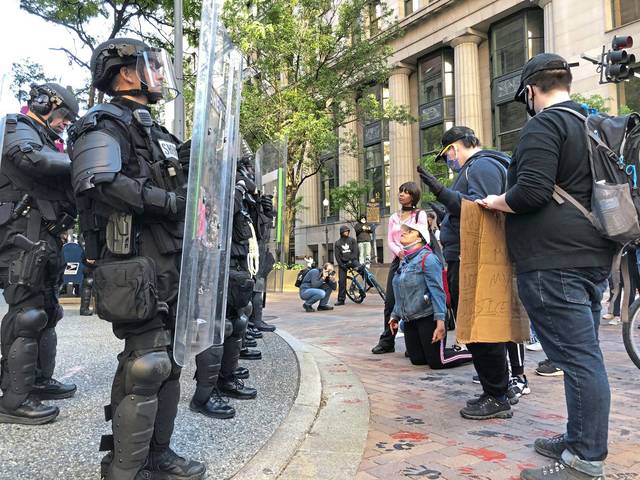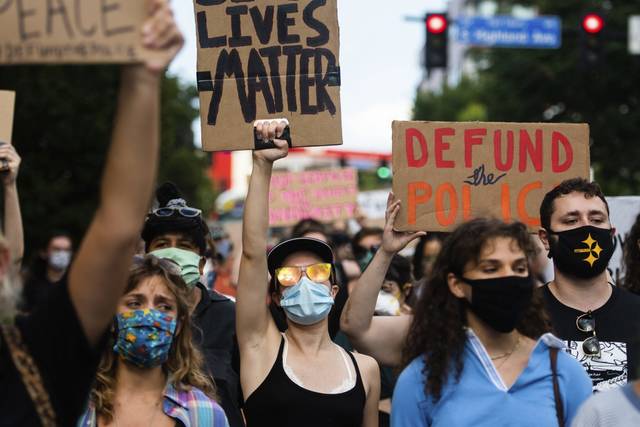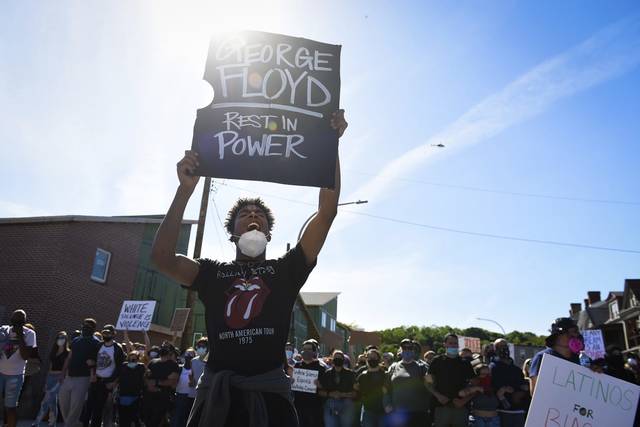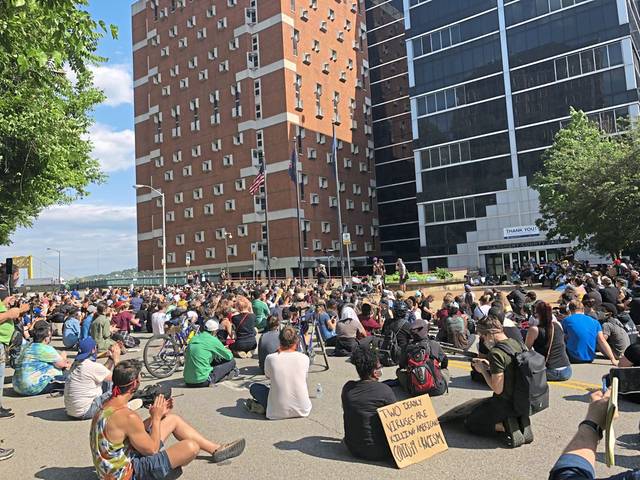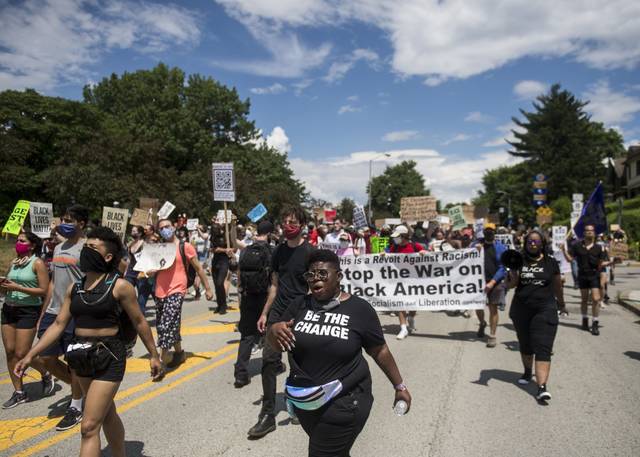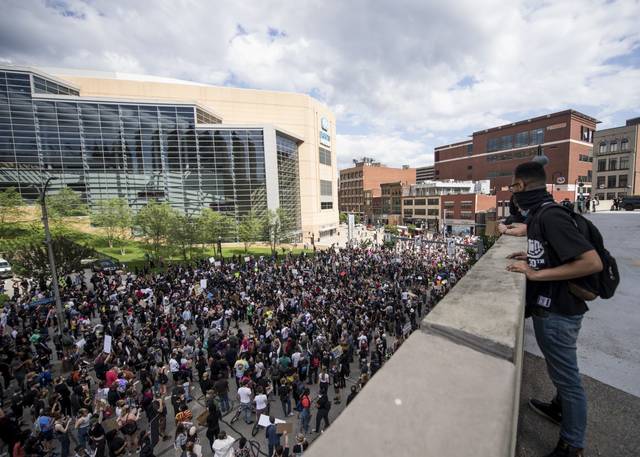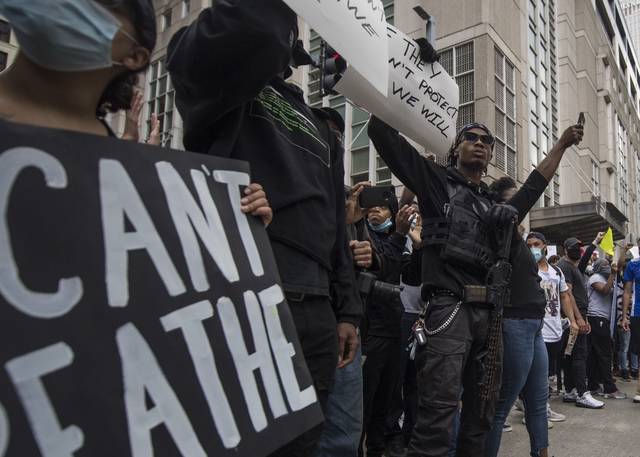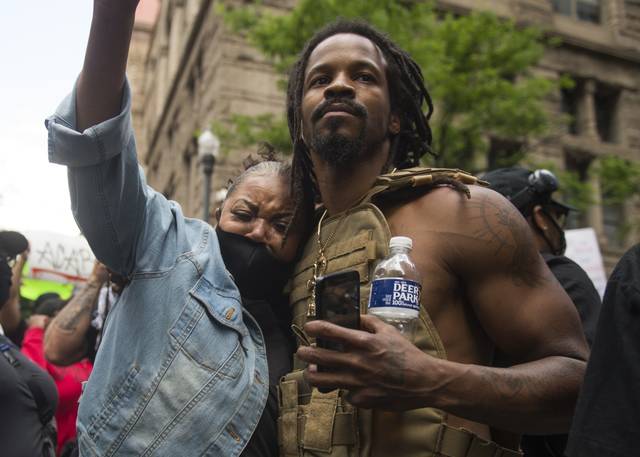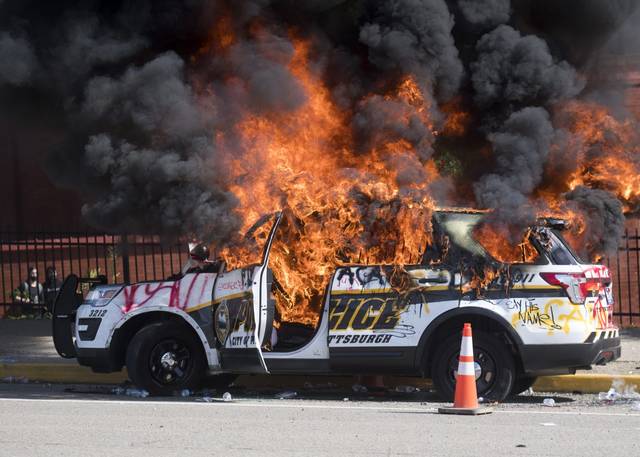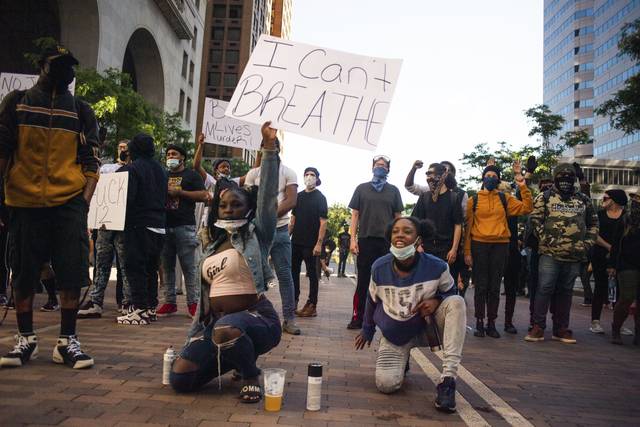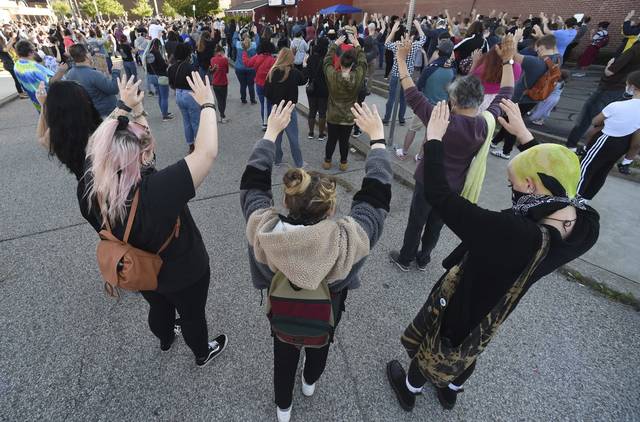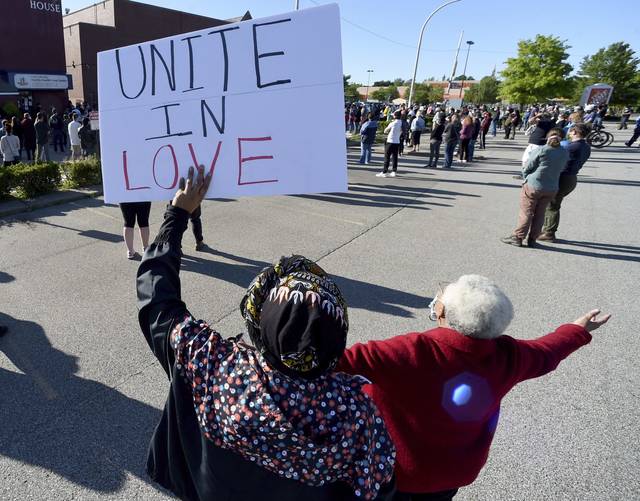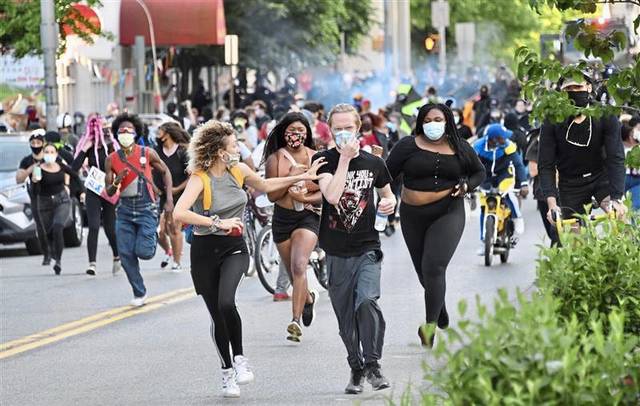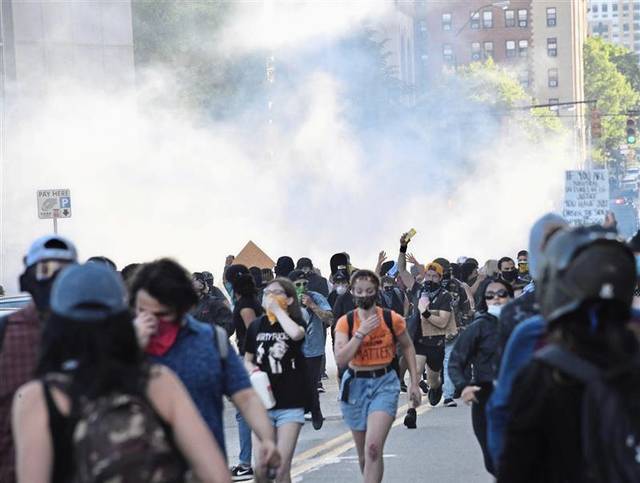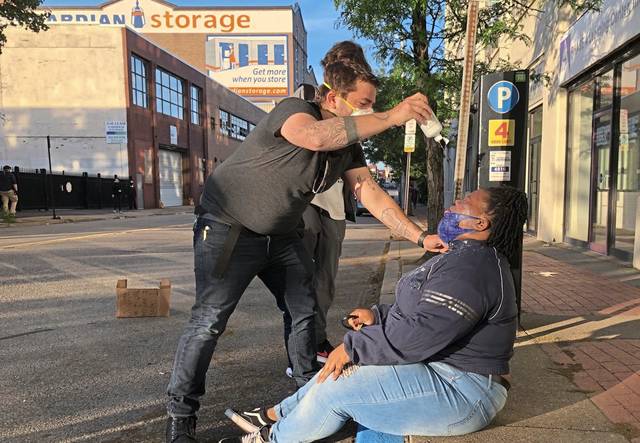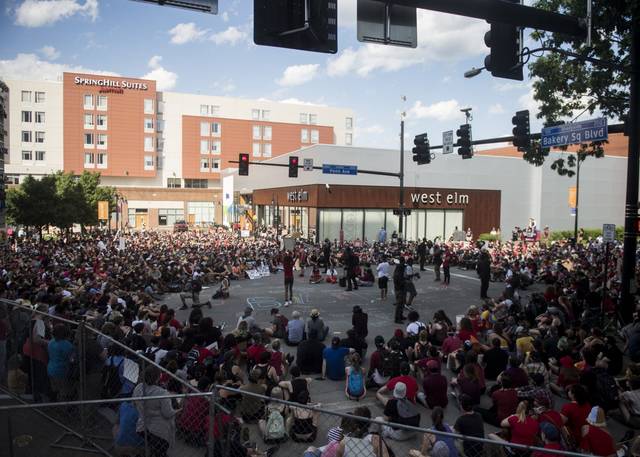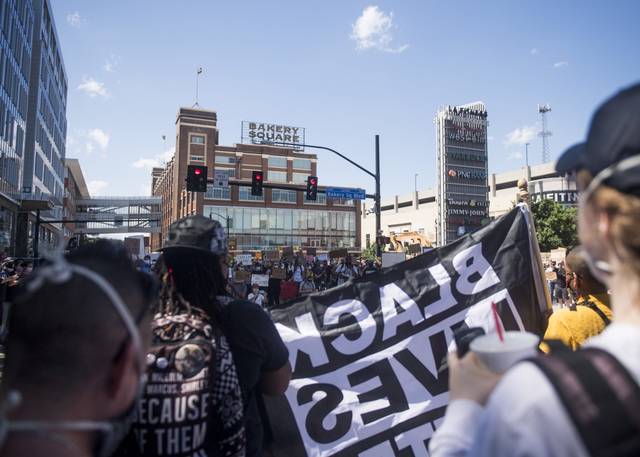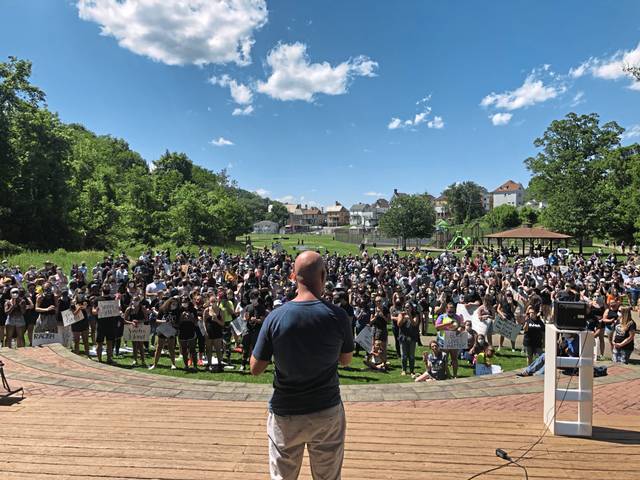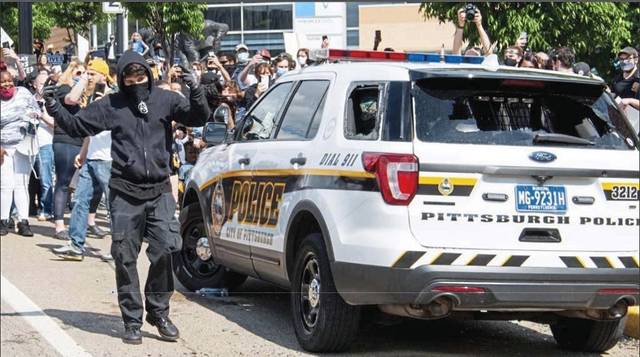Stories of the Year: After George Floyd's death, a movement for racial justice
Eight minutes changed the course of 2020.
It was Memorial Day. May 25. George Floyd was being arrested by Minneapolis police outside of a grocery store after authorities received a 911 call that someone paid with a counterfeit bill. The caller told authorities the man was acting erratically. Floyd, who is Black, matched the caller’s description of the suspect.
Minneapolis police officers responded and handcuffed Floyd. Shortly thereafter, Officer Derek Chauvin, who is white, was caught on camera kneeling on Floyd’s neck on the curb of the city street.
Floyd pleaded with Chauvin, gasping that he couldn’t breathe. He became unresponsive and later died at a nearby medical center.
Initial court documents say Chauvin had pinned Floyd for eight minutes and 46 seconds, a length later amended by prosecutors to about 7:46.
Floyd’s death sparked protests – first in Minneapolis and St. Paul, then nationwide – over police brutality. Black Lives Matter became not only a common refrain but a movement adopted by people of all ages, races and religions.
It also creates division. Many blamed BLM for violence related to protests and that the movement went too far in calling for defunding police.
The Hennepin County Medical Examiner’s office classified Floyd’s death as a homicide. A summary report listed fentanyl intoxication and recent methamphetamine use under “other significant conditions” but not under “cause of death.”
Chauvin faces second-degree murder and manslaughter charges. Three other officers — Thomas Lane, J. Alexander Kueng and Tou Thao — also faces charges in connection with Floyd’s death.
Four years earlier, then-NFL quarterback Colin Kaepernick sat and then kneeled during the national anthem to highlight what he perceived as racial injustice and police brutality.
In 2020, George Floyd’s death sparked arguably the largest civil rights movement since the 1960s.
The movement and the accompanying protests arrived in Western Pennsylvania on May 30, five days after Floyd’s death, touching off a summer of unrest and opening the dialogue over use of force by police, particularly against minorities.
May 30
The protests began peacefully but soon escalated, with thousands of people roaming Downtown Pittsburgh streets, setting police cars ablaze and taunting officers who eventually lobbed tear gas at the crowd.
At several points throughout the afternoon and evening, officials pleaded for people to avoid Downtown.
Two Pittsburgh police cars were destroyed after they were lit on fire by protesters. More than 70 businesses were damaged and looted, officials said.
A curfew went into effect at 8:30 p.m. until 6:30 a.m. the next day. A second curfew went into effect from 8:30 p.m. May 31 through 6 a.m. June 1.
“It’s definitely justified — extremely justified,” Virgol Spica, 25, of Wilkinsburg, said of the demonstrations. “We’ve protested over and over and over again, and still nothing is being done about our people being killed.”
Downtown protests began around 2 p.m. with chants and moments of silence for Floyd. People in the crowd held signs with messages such as, “Abolish the police,” “White silence is compliance,” “Police stop killing us,” “We are not equal,” “Justice for George Floyd, black lives matter,” and “Stop police brutality.”
Pittsburgh Police Chief Scott Schubert said the protests later were hijacked mostly by white male “anarchists.”
• • •
• • •
• • •
• • •
• • •
• • •
May 31
The day started shortly after first light with Downtown Pittsburgh businesses cleaning up from the aftermath of the previous night’s protests and ended in prayer as the sun set over the Eastminster Presbyterian Church in East Liberty.
In between, the region remained on edge, mirroring the mood nationwide.
Protests picked up during the afternoon and continued into the evening Downtown, and although there were some tense moments, the demonstrations remained peaceful. Protesters fist-bumped Pittsburgh police during a demonstration Downtown.
A day later, it was still unclear who ultimately was responsible for the previous day’s violence. Authorities said they arrested 46 people, most on charges of failure to disperse and disorderly conduct. And Pittsburgh police issued an arrest warrant for Brandon Jordan Bartels, 20, of Shaler in connection with vandalizing a police car.
As dusk fell, more than 100 people congregated for an early-evening vigil outside Eastminster Presbyterian. The message was of unity.
“I think sometimes people need to cry out and grieve in a safe place,” said organizer Beth Crawford of the You Are Covered Project. “It’s OK if you want to cry, it’s OK if you feel anger, but there is a way that we can feel anger in a peaceful manner.”
• • •
• • •
• • •
• • •
• • •
• • •
June 1
Peaceful protests in Pittsburgh ended in smoke, violence and confusion for the second time in three days, with police and city officials blaming small groups of instigators and saying they had no choice but to use force to disperse the crowd.
For hours, the protesters moved peacefully through East Liberty, chanting, singing and calling for justice for George Floyd. By the end of the night, 20 protesters were arrested, and nine officers were injured and later treated and released from hospitals.
This was a moment. Don’t really know what else to say. #PittsburghProtests pic.twitter.com/z4JThag39t
— Dillon Garrett Carr (@dillonswriting) June 1, 2020
Some protesters and observers claim police broke the peace about 7 p.m. Police and city officials say they let a small group of agitators go until they forced their hand, resulting in rubber bullets and smoke bombs to break up the group.
“Some people think it was tear gas,” said Narcotics and Vice Cmdr. Jason Lando, who was at the scene in East Liberty. “It was not. It was smoke.”
In a hastily called late-night news conference, Mayor Bill Peduto ordered police leaders to produce a written transcript of radio transmissions from 7 to 8 p.m.
Earlier in the day, the Shaler man accused of vandalizing a Pittsburgh police cruiser during the protests May 30 turned himself in. Brian Jordan Bartels, 20, was charged with riot, institutional vandalism, criminal mischief and five counts of reckless endangerment.
• • •
June 2
Pittsburgh police said they did, in fact, use tear gas to disperse agitators who splintered off from a peaceful protest in East Liberty the night before, contrary to what city and police officials said at a late-night news conference.
Asked specifically about crowd control, police escalation and whether tear gas was used Monday night, SWAT Officer Stephen Mescan said: “In regards to crowd munitions that are used to help manage or control a crowd, were they used tonight? No, they weren’t. We did use gas on Saturday night, which you all saw.”
Pittsburgh police also said they were looking to identify another man shown in social media destroying a police car during protests outside of PPG Paints Arena over the weekend.
June 3
Pittsburgh Mayor Bill Peduto ordered an investigation into police tactics used to disperse protesters from the streets of East Liberty two days earlier.
“Without question,” he said, “there is a difference of opinion about what happened that day and the appropriateness of the actions of the Pittsburgh Bureau of Police.”
The order came after Peduto was provided a written transcript of police command radio communications.
June 4
Protesters took to Pittsburgh streets for the fourth straight day, marching, chanting and demanding racial justice as part of protests that continued across the country.
The march remained peaceful for its duration. A Pittsburgh police officer with the bureau’s Civil Awareness Team spoke briefly to the crowd before it broke up. He said everyone can agree that what happened to George Floyd was wrong, and told the crowd the police are there “to support you and be with you along this ride to protest — to make a change.”
June 5
Pittsburgh Public Safety announced the creation of a task force composed of nine federal, state and local law enforcement agencies to investigate a homemade bomb incident and dozens of other violent actions during the protests Downtown and in East Liberty.
City police officers narrowly escaped potentially serious injuries during rioting when someone tossed what was believed to be a homemade bomb that hit one officer and blew up at the feet of another, city officials said.
June 6
Protesters took to the streets of Pittsburgh for the eighth day in a row, blocking streets in Larimer, East Liberty and Shadyside for much of the afternoon.
They burst out in upbeat chants throughout the demonstration, which lasted about four hours: “What do we want, justice! When do we want it, now!” and “Back up, back up, we want freedom, freedom” rang out.
At times, there was silence.
A few minutes of silence. Everyone still sitting quietly as I type. The chirp you hear is the crosswalk signal. Some lower their heads, raise a fist, hold up signs. I hear a helicopter, rustling trees, a chatty toddler. Otherwise, it’s quiet. pic.twitter.com/Orowhj9qxg
— Jamie Martines (@Jamie_Martines) June 6, 2020
“None of this is all about George Floyd,” said one protest organizer who goes by Giuseppe. “This is about our people, this is about our future, this is about our kids. It’s about everybody that doesn’t have a voice. We’re trying to speak up for them because it’s not OK to have so much hate surround people.”
In Irwin and Jeannette, hundreds came out to show support in calling for justice for George Floyd.
More than 150 people met up in a Magee Avenue parking lot, while a crowd of nearly 300 packed one end of Irwin Park during a demonstration.
June 7
The ninth straight day of demonstrations in Pittsburgh came to a close in Market Square with protesters calling on city officials to meet with them to discuss police department reforms.
Those demands include consistent use of police body cameras and fair treatment in any situation, whether it is a traffic stop or a possible crime, organizers said.
Pittsburgh Chief of Police Scott Schubert said in a Facebook post that he knelt with protesters during a march in Beechview two days earlier “because it felt like the right thing to do.”
In Vandergrift in Westmoreland County, between 175 and 200 protesters of all ages flooded the borough’s streets.
June 8
As protesters took the streets for a 10th straight day, the Allegheny County District Attorney’s office announced that criminal charges filed by Pittsburgh police against 39 people in connection with protests over the death of George Floyd will be withdrawn because of a lack of evidence.
The union representing the Pittsburgh police officers said it was “very disappointed” in the decision.
June 11
Hundreds showed up for a peaceful march in Dormont and Mt. Lebanon that wound up Washington Road through the two municipalities. It marked the 13th day of protests in the region.
Across the county, in the Fox Chapel area, about 500 people converged on Squaw Valley Park in O’Hara for a peaceful rally to support the Black Lives Matter movement. (The event sparked a movement to change the park’s name, citing the growing understanding of “Squaw” as slur against Native American women. On Aug. 4, O’Hara council changed the name to “O’Hara Township Community Park.”)
June 13
“Be nice.”
The simple phrase came out of the mouth of a young boy named Wyatt who showed up with his parents and friends to a Black Lives Matter gathering in a field just outside Moss Side Middle School in Monroeville’s Gateway School District.
There, young children were given the opportunity to speak their minds. Some thoughts were somber. Others were, well, child-like.
The event drew around 70 families.
A few miles away, in New Kensington, the city’s police station turned into the “people’s station” for a few hours as about 300 people took over the city hall parking lot for a Black Lives Matter protest.
June 14
Aryanna Hunter admitted she wasn’t sure what to expect after she organized a Black Lives Matter support walk through Murrysville. But after the three-hour event, she said she was astonished by the turnout.
“I thought I might be the only woman standing on a corner by myself, but we had well over 100 people marching with us today. I’m just blown away,” Hunter said.
June 17
A couple of hundred people snaked through Downtown Pittsburgh streets to protest police brutality and racism in the city’s third week of demonstrations.
“What does color matter when you need a blood transfusion — when you need an organ donation? What does color matter at this point?” said one protester.
June 18
The Allegheny County District Attorney’s Office dropped charges against 22 protesters arrested in the aftermath of protests in East Liberty about three weeks earlier.
June 19
People across the Pittsburgh area took to the streets to commemorate Juneteenth, a day marking the end of slavery 155 years ago.
Before marching, Brandi Fisher of the Alliance for Police Accountability asked the crowd gathered to remember three people who lost their lives to gun violence in Wilkinsburg earlier in the day, about a mile away from the Martin Luther King Jr. East Busway where the group started the commemoration.
July 16
About 40 people brought signs pushing for racial justice and stood in the parking lot listening to speakers on a hot day as part of a rally in Jeannette.
The group started with a prayer and then took to the city’s downtown area led by police officers. They yelled chants such as “My skin is not a crime” and “Stop killing us.”
July 30
While Vice President Mike Pence was attending a “Cops for Trump” rally in downtown Greensburg, a half-mile away in St. Clair Park, city resident Arlena Williams was describing the fear she felt recently watching her son get pulled over by police right near her front door.
“Our fears are not superficial,” Williams said. “When I hear a siren, or an ambulance, I pray for the safety of our children. Because the reality is, they are in danger.”
Williams was one of several speakers at a “Rally for Black Lives” event sponsored by Voice of Westmoreland and held Thursday morning just before the “Cops for Trump” event.
Aug. 16
What was meant to be a “low-visibility arrest” of a protester by plainclothes officers in Oakland a day earlier turned into a social media firestorm, pushing Mayor Bill Peduto to call a news conference to express his concerns over the incident while police leadership explained why they thought their tactics were necessary.
“Why are we having plainclothes officers in an unmarked vehicle arrest somebody through a ‘pop-out tactic?’ ” Peduto said.
Pittsburgh police Cmdr. Ed Trapp alleged Matthew Cartier, 24, was blocking an intersection unnecessarily, stepping in front of cars and attempting to direct traffic during the protest. “When high-visibility stuff takes place with these marches, it tends to attract a crowd and incite things further,” he said.
Protesters marched on Peduto’s Point Breeze home late in the afternoon.
Aug. 17
More Pittsburgh city leaders added their voices to a growing chorus of concern and alarm over tactics used by city police in the arrest of a protester in Oakland, with Mayor Bill Peduto decrying the arrest as “disturbing” and barring the tactic from use during peaceful protests.
Pittsburgh Councilwoman Deb Gross likened the arrest Saturday to a “hostile abduction” that belongs among military wartime tactics, not in Pittsburgh policing.
Aug. 19
An hours-long protest outside the Point Breeze home of Pittsburgh Mayor Bill Peduto ended in chemical spray, chaos and one arrest after a confrontation between protesters and police in riot gear near Mellon Park.
The mayor, who was not home when protesters descended on his street the night prior, was waiting for demonstrators on his front stoop when they arrived.
Many questions and demands of the mayor revolved around the June 1 protest in East Liberty where officers used tear gas and projectiles to disperse protesters, as well as the weekend arrest of a protester by plainclothes officers in an unmarked van.
The tense dialogue eventually broke down, with protesters returning to chants such as, “Hey hey, ho ho, Bill Peduto has got to go,” among others.
One protester, Ian Frazier, 26, of Pittsburgh, was charged with aggravated assault and riot after police allege he pushed his bicycle against and struggled with officers.
Aug. 21
Pittsburgh Police Special Response Teams trained in traditional crowd-control tactics will no longer be the first line of response during protests, Mayor Bill Peduto said, two days after police clashed with protesters just blocks from his front door.
It’s one of a number of changes Peduto laid out in response outcry over the police bureau’s response to the near-daily protests in city streets.
Other changes include appointing a new commander to oversee police response to protests and adding spots for members of the Civil Affairs Unit and Public Safety’s Community Engagement staff at command posts.
Sept. 1
Changes in the way the Pittsburgh police department responds to protests in the city appear to be working, Mayor Bill Peduto said.
“I think that we have been able to scale back our response from one that was more about domination to one that looks to deescalate,” he said.
But at least some protesters disagreed.
“Nothing has really changed,” said Dena Stanley of the LGBTQ group TransYOUniting.
Sept. 7
Pittsburgh police said they are seeking information about confrontations between protesters and the public that occurred two days earlier in Downtown Pittsburgh as they investigate videos that surfaced on social media.
Videos on social media showed demonstrators hitting a person carrying a bicycle and yelling at restaurant patrons on Penn Avenue. Another video, which appears to be taken from inside a McDonald’s restaurant, shows some of the same demonstrators chanting, clapping and dancing to music while apparently waiting for their orders
A protester said the videos don’t properly capture tensions on both sides of the demonstrations.
Sept. 8
Pittsburgh Public Safety officials condemned “the actions of a few protesters” during weekend protests.
“People have the right to dine in public without being accosted and without vulgarities being thrown at them,” Public Safety Director Wendell Hissrich said in a statement. “What we saw this weekend was assault and battery. It was embarrassing.”
Sept. 12
Hundreds of people marched across several Pittsburgh neighborhoods in the name of social justice and police accountability.
The demonstration marked the 16th and final Civil Saturdays, a weekly protest organized by the Black, Young, & Educated youth-led organization in support of the broader Black Lives Matter movement.
“We’ve been on a 16-week journey,” organizer Giuseppe Bagheera, 18, of the North Side told the crowd. “If this is something that you really are passionate about, which you should be, I need you to not just go to another protest, I need you to be a voice.”
The decision to end the weekly event was made about three days ago, Bagheera said, with organizers needing a break and encouraging other local groups and individuals to move forward with other events and activities that support the movement.
Sept. 15
Three Pittsburgh protesters have been charged for a pattern of disorderly conduct Sept. 5 that started at the McDonald’s on Liberty Avenue and continued to an area outside Sienna Mercato on Penn Avenue.
Parts of the protest were captured on video that went viral on social media nationwide and caught the attention and condemnation of President Donald Trump.
Police filed charges against Kenneth McDowell, 33, also known as Kenny West; Shawn Green, 24, also known as Lorenzo Rulli; and Monique Craft, 35, also known as Nique Craft.
Sept. 22
A Shaler man pleaded guilty in federal court to initiating the destruction of a Pittsburgh police car during a May protest over the death of George Floyd outside PPG Paints Arena.
Brian Bartels, 20, pleaded guilty to a charge of obstruction of law enforcement during civil disorder before U.S. District Judge Arthur J. Schwab.
U.S. Attorney Scott W. Brady said Bartels’ actions were the “inflection point” in the demonstration that turned violent.
“What was peaceful became lawless. Mounted Pittsburgh Police Officers were attacked. Reporters were attacked and their camera destroyed. What started as a peaceful demonstration, turned into a violent evening of destruction and looting throughout Downtown Pittsburgh,” Brady said.
Schwab scheduled sentencing for Jan. 27. Bartels faces a maximum sentence of five years in prison, a $250,000 fine or both.
Remove the ads from your TribLIVE reading experience but still support the journalists who create the content with TribLIVE Ad-Free.


